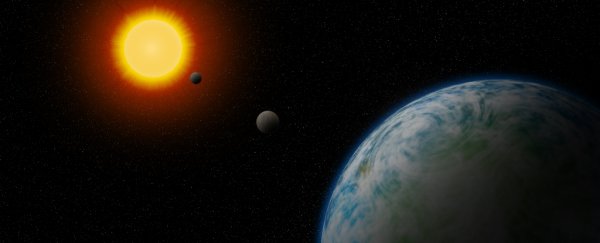A cache of five newly discovered exoplanets orbiting nearby stars has been revealed in a new study. The bounty includes two potentially habitable super-Earths that are perfect candidates to study further in our search for life outside the Solar System, according to the research team.
The two planets are called GJ 180 d and GJ 229A c, clocking in at 7.5 and 7.9 times the mass of Earth, respectively. These newly found worlds are at respective distances of 40 light-years and 19 light-years from Earth.
Both orbit red dwarf stars, which, generally speaking, is thought to not be a good thing for potential life. That's because these types of stars tend to be pretty violent, lashing their surroundings with flare activity and radiation.
That's not necessarily a dealbreaker, depending on the star - some are much less violent than others.
But the other big problem is that red dwarfs are quite a bit cooler than most main sequence stars. As a result, their Goldilocks zone (where temperatures are conducive to liquid water on the surface of a planet) is located pretty close to the star.
In turn, this means that planets in that zone are more prone to tidal locking, where one side of the planet is always facing the star, and the other is facing away. This makes one side searingly hot and constantly bathed in stellar radiation, while the other side lies in chilly darkness.
GJ 180 d has an orbital period of 106 days, and the team thinks this particular planet is far enough from its star Gliese 180 that it would not be tidally locked.
"GJ 180 d is the nearest temperate super-Earth to us that is not tidally locked to its star, which probably boosts its likelihood of being able to host and sustain life," said astronomer Fabo Feng of the Carnegie Institution for Science.
Meanwhile, GJ 229A c has an orbital period of 122 days, but its star Gliese 229A is more massive than Gliese 180, so this world may be tidally locked. However, there's something else interesting about the star: Gliese 229A is in a binary system with a brown dwarf, Gliese 229B.
These objects are sometimes called "failed stars", objects too big to be a planet, but too small to fuse hydrogen in their cores. They form like stars, from the gravitational collapse of a clump of gas - as opposed to the slow accretion process that creates planets - but it's unknown if they can host planets.
GJ 229A c is now officially the closest known temperate super-Earth in a system that includes a brown dwarf, which means it makes an excellent candidate for studying how planets form and evolve in such systems, the researchers said.
The planets were discovered using an indirect approach called the radial velocity method. Although it may not seem like it, planets orbiting a star exert a gravitational influence on that star, causing it to 'wobble' slightly as the planet tugs it.
This can be used to infer not just the presence of planets, but calculate their mass and orbital period and distance. In turn, those data help astronomers to infer the composition and temperature of said planets.
Because these particular systems are so close, the researchers believe that the next generation of powerful telescopes could finally give us direct images of these planets, telling us even more - such as whether the planet has an atmosphere, or even water.
In addition, the haul of planets outlined in this latest paper includes a mini Neptune-mass planet called GJ 433 d. It's the closest and coldest of its kind ever discovered, which makes it the best candidate yet for attempting direct imaging of an ice giant exoplanet.
"Our discovery adds to the list of planets that can potentially be directly imaged by the next generation of telescopes," Feng said.
"Ultimately, we are working toward the goal of being able to determine if planets orbiting nearby stars host life."
The research has been published in The Astrophysical Journal Supplement Series.
